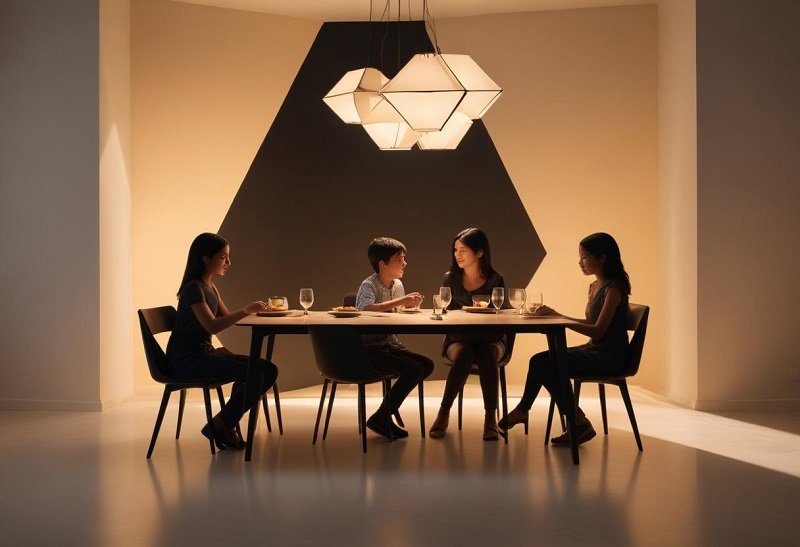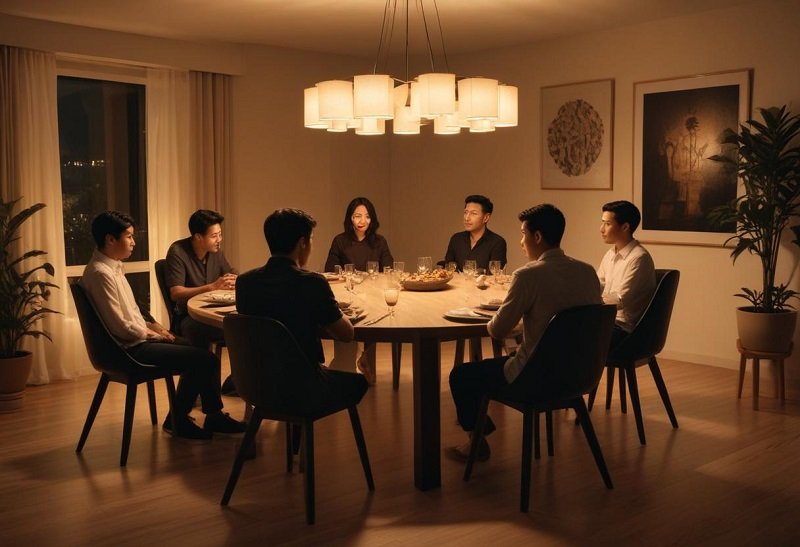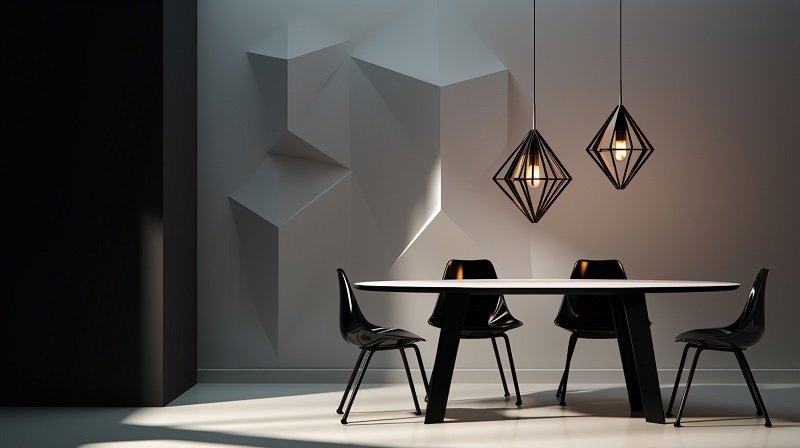Blog
How to Choose a Dining Table Size?

Introduction
Choosing the proper dining table size is more than simply fitting a piece of furniture into a room; it’s about creating a place that suits your lifestyle while also improving the aesthetics of your home. Venus Home Furniture understands the difficulty of making the right decision regarding home décor. Drawing on our significant expertise in assisting clients in creating their ideal dining sets, we’re here to walk you through selecting a dining table size that meets your needs and your space measurements.
Dining Room Dimensions
Understanding the measurements of your dining room is the first step in determining the right table size. Like a tailor measures cloth before making a suit, you must measure your room to achieve a perfect fit.
1- Step into the Room
Enter your dining room with a tape measure in hand. Start by measuring the length and breadth of the room. Take close note of these dimensions, as they will serve as the basis for your dining set size selection. It’s also important to consider the room’s height. Low ceilings may need a table that does not dominate the area, but higher ceilings can enable larger items.

2- Consider the Shape
Rooms come in various shapes, which influence the style of table that looks best. A rectangle room, for example, frequently works well with a long, rectangular dining set, making the most use of space and generating a balanced visual flow. In contrast, a square space may benefit from a round or square table, creating a warm and intimate ambiance.
3- Account for Other Furniture
Think about the other pieces of furniture that will share space with your dining set. Sideboards, buffets, and extra seating should all be addressed while measuring. You want to make sure there’s enough space for moving around the room without knocking into other stuff. Consider having a dinner party where guests can freely move from table to sideboard without feeling crowded.
4- Creating Comfortable Walkways
A good rule of thumb is to provide at least three feet of space around the table for easy mobility. This area allows seats to be pushed out allowing people to move about freely.

How to Calculate the Right Size Table?
After you’ve measured your dining room, the following step is to determine the perfect dining set size. This involves figuring out the measurements that will not only fit the area but also suit your lifestyle and aesthetic tastes.
Dining Table Height:
The standard height for dining tables is between 28 and 30 inches. This height is appropriate for most people and provides enough legroom. When choosing a table, consider the height of your seats as well. They should fit nicely under the table without being overly tight or loose.
Dining Table Width and Length:
The width and length of your table will be determined by the design of the space and how many people you intend to seat. To provide a comfortable eating experience, allow at least 24 inches of table width per person. For example, a six-person table should be around 48 inches broad and 72 inches long.

Number of People – Seating Capacity:
Consider the usual number of people who will be utilizing the dining set. Do you host large gatherings regularly, or do you normally just invite intimate family members? Seating capacity is critical in deciding table size. For example, if you routinely hold dinner parties for eight, you should aim for a table that can comfortably accommodate eight people.
Tabletop Space Per Person:
Each diner needs around 24 inches of room around the table’s surface to dine comfortably. This area allows you to organize personal objects such as plates, glasses, and dishes without feeling locked up. The diameter of a round table should allow enough personal space for everyone seated.
Shape of the Room and Table:
The shape of your dining set should match the shape of the space. Rectangular tables perform well in long, narrow rooms, but round tables are best for smaller, square settings. Oval tables provide a middle ground, with a soft, extended design that may accommodate a variety of room layouts.

Your Lifestyle:
Your lifestyle is an important factor in determining the appropriate dining table size. If you enjoy hosting large dinner parties, choose a dining set with extendable leaves that may be used as required. If your dining room also serves as a workshop or a place for children to conduct schoolwork, a solid, large table is necessary.
Conclusion
Choosing the right dining table size is a combination of art and science. It needs careful consideration of your dining room’s proportions, your lifestyle, and the number of people you intend to seat daily. Taking these factors into account, you can choose a dining set that not only matches your room but also improves the whole dining experience.
Venus Home Furniture believes that every house should have a dining table that brings people together and fosters a pleasant environment. Whether you’re throwing a huge dinner party or just having a peaceful family meal, the right table size makes all the difference.
FAQs
1- How do I measure my dining room to find the right table size?
To measure your dining room, start by measuring the length and width of the space. Ensure there is at least 36 inches of clearance around all sides of the table for chairs and movement. Use these dimensions to determine the maximum table size that fits comfortably in your dining area.
2. What is the standard height for a dining table?
The standard height for a dining table is typically between 28 to 30 inches. This height allows for comfortable seating and legroom for most people. Counter-height tables, which are around 36 inches, can also be a stylish option for more casual settings.
3. How much space should I allow per person at the dining table?
Generally, you should allow 24 to 30 inches of space per person at your dining table. This ensures everyone has enough room to eat comfortably without feeling cramped.
4. What shapes are best for different room sizes and layouts?
- Rectangular tables: Ideal for long, narrow rooms. They offer plenty of seating and are great for larger gatherings.
- Round tables: Suitable for smaller spaces and create a cozy, intimate setting. They also encourage conversation by allowing everyone to see each other easily.
- Square tables: Perfect for square rooms and can create a balanced, symmetrical look.
- Oval tables: Combine the benefits of rectangular and round tables, providing ample seating and a softer aesthetic.
5. How do I determine the seating capacity of a dining table?
The seating capacity depends on the size and shape of the table. For example, a 60-inch round table typically seats 6 people, while an 84-inch rectangular table can seat 8. Always consider the table’s dimensions and ensure there’s enough elbow room for each person.
6. What materials are best for dining tables?
The choice of material depends on your style preference and lifestyle needs:
- Wood: Classic and durable, offering a warm and inviting look.
- Glass: Modern and visually light, making the space appear larger.
- Metal: Sleek and industrial, ideal for contemporary spaces.
- Marble: Luxurious and elegant but requires more maintenance.
7. How does my lifestyle affect my dining table choice?
Consider how you use your dining table. If you host large gatherings frequently, a larger table with extension leaves might be ideal. For smaller families or couples who prefer cozy meals, a round or square table might be better. Think about durability if you have young children or often entertain.
8. What are extension leaves, and how do they work?
Extension leaves are additional sections that can be added to a dining table to increase its length. They can be stored separately or within the table itself, providing flexibility for hosting larger gatherings when needed.
9. How do I maintain and care for my dining table?
Maintenance depends on the material:
- Wood: Regularly dust and polish to maintain its finish. Use coasters and placemats to prevent scratches and heat damage.
- Glass: Clean with glass cleaner to avoid streaks. Be careful with heavy objects to prevent chipping.
- Metal: Wipe with a damp cloth and avoid abrasive cleaners that could scratch the surface.
- Marble: Clean with a mild detergent and water, and seal periodically to prevent staining.
10. How can I make my dining table more versatile?
Choose a table with a neutral design that can be dressed up or down with different table linens, centerpieces, and chairs. Extension tables add versatility by allowing you to adjust the size as needed. Additionally, consider multifunctional furniture, such as benches that can double as extra seating or storage.


